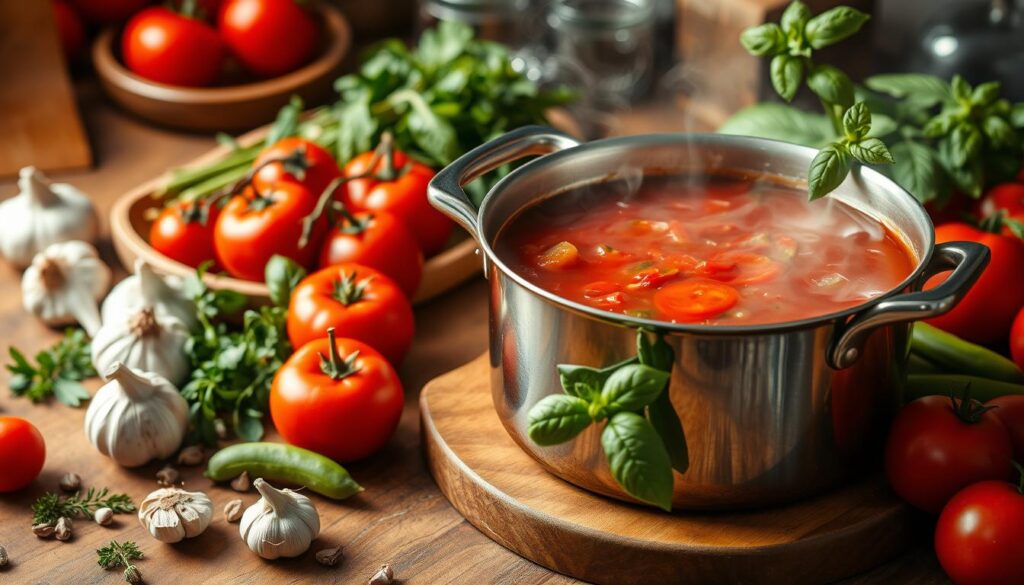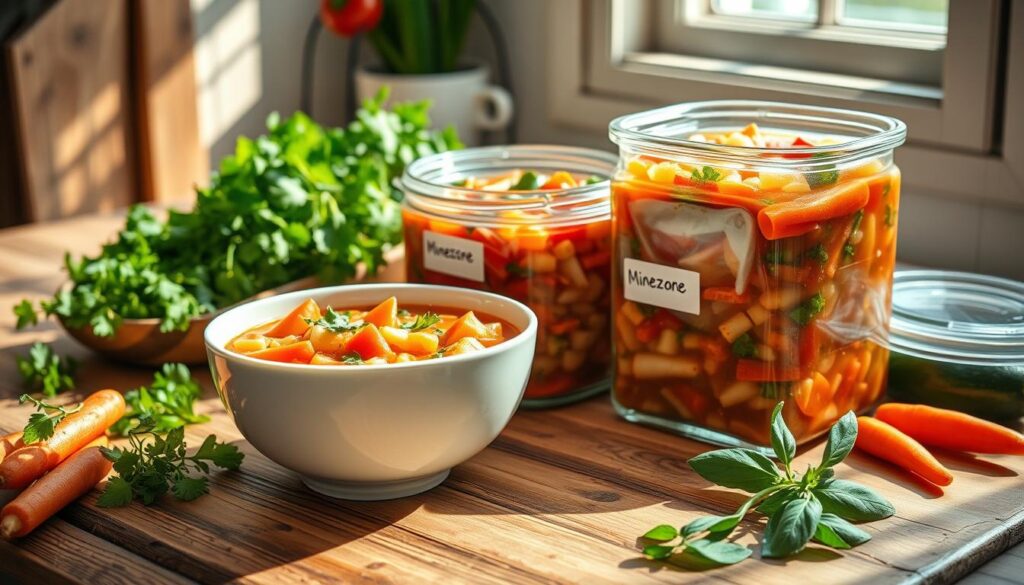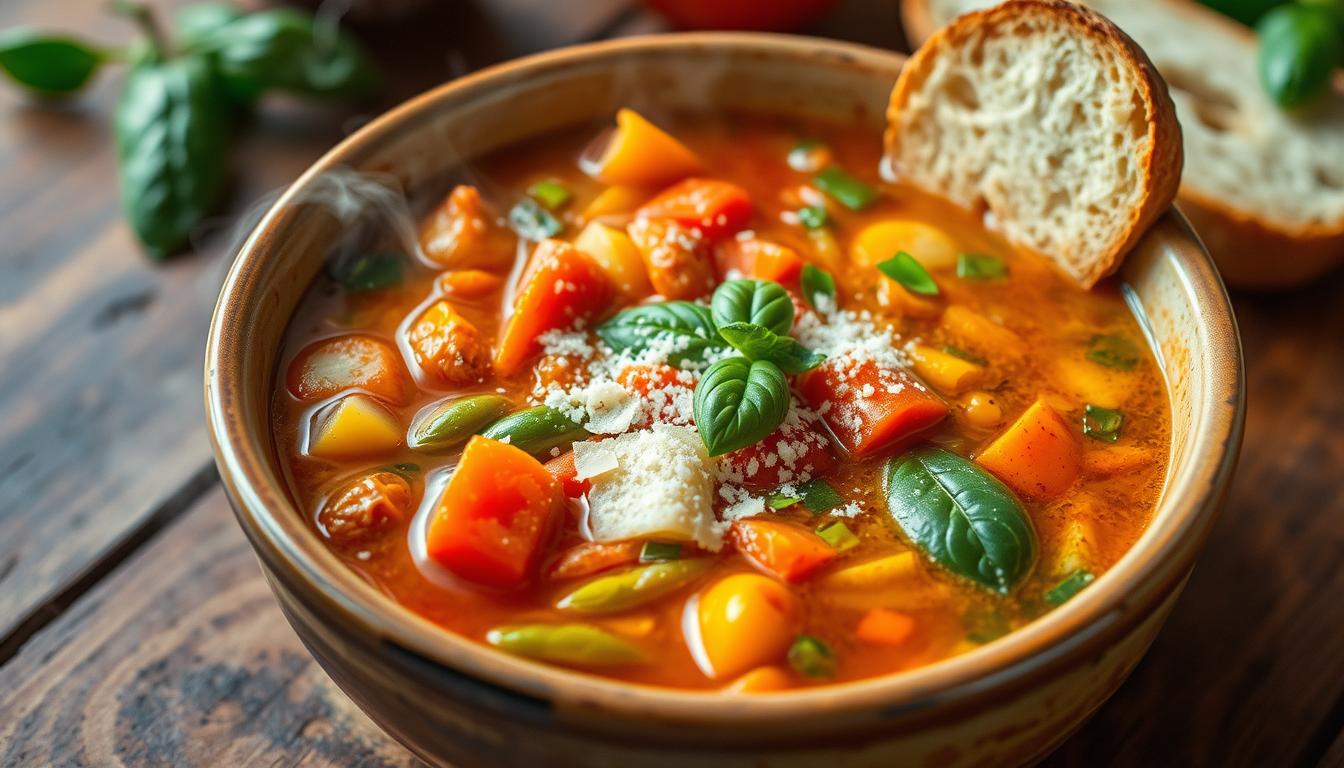Growing up in an Italian-American kitchen, minestrone soup was a comfort. It was more than food; it was a warm hug from family traditions. Every spoonful reminded me of my grandmother’s kitchen, where vegetables swirled in a flavorful broth.
Minestrone soup is the essence of Italian home cooking. It’s a nourishing dish that turns simple ingredients into a flavorful mix. It’s perfect for a quick dinner or a cozy meal on a cold night.
Key Takeaways
- Discover the rich cultural roots of traditional minestrone soup
- Learn how to create an authentic Italian vegetable soup
- Explore versatile ingredient combinations for your recipe
- Understand the nutritional benefits of this classic dish
- Master simple cooking techniques for perfect minestrone
Understanding Traditional Minestrone Soup
Minestrone is more than just a soup; it’s a journey through Italian history. It comes from the cucina povera tradition. This peasant dish shows how people made meals from simple things.
Minestrone’s history goes back before the Roman Empire. Archaeologists found evidence of its recipes from the 2nd century B.C. The first written recipes were around 30 A.D.
Origins in Italian Cuisine
Minestrone’s story is tied to Italy’s farms and economy. Important moments include:
- 2nd Century B.C.: Early soup preparations
- 1500s: Tomatoes were added, making the recipe more complex
- Ongoing changes based on what vegetables are in season
Regional Variations Across Italy
Every Italian region adds its own twist to minestrone. They use local ingredients and traditions. This shows how versatile the soup is.
| Region | Unique Characteristics |
|---|---|
| Romagna | Uses beef broth, emphasizing robust flavors |
| Northern Italy | Includes more beans and root vegetables |
| Southern Italy | Lighter version with more tomato-based ingredients |
Cultural Significance of Minestrone
“The character of authentic Italian soup depends on two things: The season and the place.” – Marcella Hazan
Minestrone is more than food; it’s about community and family. It shows Italy’s love for making something special from simple things. This soup is about creativity and the joy of eating together.
Essential Ingredients for Authentic Minestrone Soup
To make a real vegetable soup, you need the right ingredients. These ingredients add depth and flavor to your minestrone. Let’s dive into the key parts that make this bean soup stand out.
A great pasta soup starts with fresh veggies and aromatics. Here are the must-haves for a soup that’s a true culinary work of art:
- Base Vegetables:
- 1 large yellow onion (diced)
- 2 stalks of celery (diced)
- 3 large carrots (diced)
- Protein Components:
- 1 can (15 oz) kidney beans
- 1 can (15 oz) cannellini beans
- Tomato Elements:
- 1 can (28 oz) diced tomatoes
- 5 tablespoons tomato paste
“The secret to a great minestrone is balancing fresh ingredients and allowing each vegetable to shine.” – Italian Cooking Tradition
The pasta you choose can change the soup’s feel. Try 1 cup of elbow pasta or ditalini for a real touch. Add fresh basil and parmesan cheese for an amazing flavor boost.
| Ingredient Category | Recommended Quantity | Purpose |
|---|---|---|
| Fresh Vegetables | 4-5 cups | Provide texture and nutritional value |
| Beans | 2 cans (15 oz each) | Add protein and thickness |
| Pasta | 1 cup | Create hearty consistency |
| Herbs | 1/4 cup fresh | Enhance flavor profile |
Minestrone is all about being flexible. You can change it up with what’s in season and what you like.
Selecting the Perfect Vegetables for Your Soup
Making a tasty minestrone soup begins with picking the right veggies. The taste and health of your soup depend on fresh, quality produce. This produce should match well with the veggie broth.
Seasonal Vegetable Highlights
Every season has its own special veggies for minestrone. Summer brings in zucchini and sweet corn. Winter offers root veggies that make your soup richer.
- Summer seasonal vegetables: zucchini, bell peppers, corn
- Fall seasonal vegetables: butternut squash, pumpkin, carrots
- Winter seasonal vegetables: kale, cabbage, potatoes
- Spring seasonal vegetables: asparagus, peas, artichokes
Root Vegetables and Greens
Root veggies and leafy greens are key for a hearty minestrone. They add texture, nutrients, and flavor to your broth.
| Root Vegetables | Leafy Greens |
|---|---|
| Carrots | Spinach |
| Parsnips | Kale |
| Turnips | Swiss Chard |
| Sweet Potatoes | Collard Greens |
Fresh vs. Frozen Vegetables
Fresh veggies are best, but frozen ones are also good. Pro tip: Go for frozen veggies that were flash-frozen at peak ripeness. This keeps their flavor and nutrients high.
“The secret to a great minestrone is using the freshest seasonal vegetables available.” – Italian Cooking Experts
The Role of Beans and Legumes
Beans are the heart of pasta e fagioli, adding depth and nutrition to your minestrone soup. These tiny powerhouses turn a simple bean soup into a hearty, satisfying meal. They are packed with protein and flavor.
When picking beans for your minestrone, consider these tasty options:
- Cannellini beans – creamy and mild
- Kidney beans – robust and rich
- Great Northern beans – delicate texture
- Borlotti beans – traditional Italian favorite
- Chickpeas – adds nutty complexity
“Beans are not just an ingredient, they’re a culinary tradition passed down through generations of Italian cooking.” – Italian Cooking Wisdom
Your bean choice greatly affects the soup’s nutrition. A single serving can give you about 30% of your daily fiber. Pro tip: Canned beans are great, but soaking dried beans overnight can make your soup more authentic.
| Bean Type | Protein (g) | Fiber (g) |
|---|---|---|
| Cannellini | 15 | 11 |
| Kidney Beans | 13 | 13 |
| Chickpeas | 14 | 12 |
Exploring the world of beans can turn your minestrone into a nutritional powerhouse. Try different legumes to find your favorite bean soup mix!
Pasta Varieties for Minestrone Soup
Choosing the right pasta can make your one-pot meal special. In a delicious pasta soup like minestrone, the pasta shape is key. It affects both texture and how well it absorbs flavors.
Traditional Pasta Shapes
Italian cuisine has many classic pasta shapes for minestrone:
- Ditalini – tiny tube-shaped pasta ideal for soups
- Small shells – capture broth beautifully
- Orzo – rice-shaped pasta that blends seamlessly
- Acini di Pepe – tiny pearl-like pasta
Cooking Tips for Perfect Pasta
To get the best pasta soup, follow these tips:
- Add pasta during the last 8-10 minutes of cooking
- Stir occasionally to prevent sticking
- Use about 1 cup of pasta per 4 cups of broth
- Choose smaller pasta shapes for easier eating
Gluten-Free Alternatives
For those with dietary restrictions, there are great gluten-free pasta options for minestrone:
| Pasta Type | Cooking Time | Texture |
|---|---|---|
| Cassava Orzo | 7 minutes | Smooth, similar to traditional pasta |
| Rice Pasta | 8-10 minutes | Light and delicate |
| Chickpea Pasta | 6-8 minutes | Hearty and protein-rich |
“The right pasta can elevate a simple soup into a memorable culinary experience.”
Remember, the key to a perfect pasta soup is experimenting. Find the shape that suits your taste. Don’t be afraid to try different varieties and make the recipe your own!
Creating the Perfect Tomato Broth Base

Making a great tomato broth is key to a tasty tomato soup or minestrone. It sets the flavor for the whole dish. So, picking and preparing ingredients well is very important.
Start with top-notch ingredients for a rich tomato broth. For the best taste, use:
- Fire-roasted crushed tomatoes (14.5-ounce can)
- Fire-roasted petite diced tomatoes (14.5-ounce can)
- Low-sodium vegetable or chicken broth (6 cups)
- Tomato paste for depth of flavor
“A great tomato broth transforms an ordinary soup into a culinary masterpiece.”
Here are some key steps for making your tomato broth:
- Sauté onions and garlic in olive oil
- Add tomato paste and cook for 2-3 minutes
- Put in canned tomatoes and broth
- Simmer for about 20 minutes to get rich flavors
The secret to a great tomato broth is finding the right balance. A little balsamic vinegar (½ tablespoon) can make a big difference. It adds a special touch to your tomato soup.
| Ingredient | Quantity | Purpose |
|---|---|---|
| Crushed Tomatoes | 14.5 oz | Base flavor and texture |
| Diced Tomatoes | 14.5 oz | Additional texture and brightness |
| Vegetable Broth | 6 cups | Liquid base and depth |
| Tomato Paste | 2 tablespoons | Flavor concentration |
Pro tip: Choose BPA-free canned tomatoes for both health and flavor considerations.
Step-by-Step Cooking Instructions
Making a tasty broth-based soup like minestrone needs careful steps and focus. It’s a great choice for those who want a hearty, healthy meal with less cleanup.
Preparation Methods
First, get your ingredients ready and chop your veggies. Cut celery, carrots, and onions into the same size pieces for even cooking. Finely chop the garlic for extra flavor.
- Clean and chop vegetables uniformly
- Measure out 2 tablespoons of olive oil
- Prepare 2 cloves of minced garlic
- Drain and rinse cannellini beans
Cooking Techniques
Building layers of flavor is key to a great minestrone. Start by sautéing your veggies in olive oil for 3-4 minutes. This makes them fragrant and slightly soft.
- Heat olive oil in a large pot
- Sauté vegetables until soft
- Add garlic and cook for 30 seconds
- Pour in chicken broth and diced tomatoes
Timing and Temperature
Getting the cooking time right is important for the perfect texture. Simmer your soup gently. This helps develop rich flavors without overcooking the veggies.
| Ingredient | Cooking Time | Temperature |
|---|---|---|
| Vegetables | 3-4 minutes | Medium heat |
| Carrots and Potatoes | 20 minutes | Low simmer |
| Pasta | 8 minutes | Gentle boil |
“The secret to a great minestrone is patience and allowing flavors to develop slowly.” – Italian Cooking Tradition
Don’t forget to season with 1 teaspoon of dried Italian seasoning, 2 teaspoons of kosher salt, and ½ teaspoon of black pepper. Add pasta in the last 8 minutes to avoid overcooking.
Herb and Seasoning Guide
Making the perfect minestrone soup is all about the right herbs and seasonings. These elements bring out the true flavors of Italian cuisine. They turn simple ingredients into a dish you’ll always remember.
The key to a great minestrone is choosing the right herbs. Italian seasonings add depth and complexity. They create a mix of flavors that excite your taste buds.
Essential Herbs for Your Minestrone
- Basil: Brings a fresh, aromatic sweetness
- Oregano: Adds earthy, slightly bitter notes
- Thyme: Provides subtle, woodsy undertones
- Bay Leaves: Imparts rich, deep flavor
“Herbs are the soul of Italian cooking, transforming simple ingredients into extraordinary meals.”
Parmesan cheese is also key. It boosts the soup’s umami flavor. Add it just before serving to make the soup even more complex.
Seasoning Measurements
| Herb | Quantity per 3-Liter Soup | Flavor Profile |
|---|---|---|
| Dried Oregano | 1 teaspoon | Earthy and robust |
| Fresh Rosemary | 1 sprig | Aromatic and pine-like |
| Bay Leaves | 2 whole leaves | Deep, warming flavor |
| Grated Parmesan | 1/4 cup | Rich and savory |
Getting the right balance of herbs is crucial. Start with small amounts and adjust to taste. This way, the true flavors of Italian cuisine will shine in your soup.
Storage and Freezing Tips
Keeping your vegetarian soup fresh is key. Use the right storage methods to enjoy it for days or weeks. This way, you can savor your minestrone whenever you like.

Refrigeration Best Practices
Put your soup in an airtight container to keep it fresh. Minestrone stays good in the fridge for up to 5 days. Cool it down first to stop bacteria from growing.
- Use glass or ceramic containers with tight-fitting lids
- Cool soup to room temperature within 2 hours of cooking
- Store in the coldest part of your refrigerator
Freezing Your Vegetarian Soup
Freezing your minestrone makes it last longer. It’s a great way to enjoy a healthy meal weeks later. Just make sure to prepare it right for the best results.
| Storage Method | Duration | Recommended Approach |
|---|---|---|
| Refrigeration | Up to 5 days | Airtight container |
| Freezing | Up to 3 months | Leave 1-inch space in container |
Reheating Instructions
Ready to enjoy your soup again? Here’s how to reheat it to its former glory.
- Thaw frozen soup in the refrigerator overnight
- Reheat on stovetop over medium heat
- Stir occasionally to prevent sticking
- Add a splash of water or broth if soup seems too thick
Pro tip: Cook pasta separately when planning to freeze to prevent mushy texture during reheating.
By following these storage tips, your soup stays tasty and healthy. Enjoy it whenever you need a comforting meal.
Serving Suggestions and Garnishes
Turn your peasant soup into a masterpiece with these tips. Minestrone is more than a simple soup. It’s a feast of flavors, ready to shine with the right touches.
Give your minestrone soup the spotlight when serving. Here are some classic garnishing ideas:
- Sprinkle freshly grated Parmesan cheese
- Drizzle high-quality extra-virgin olive oil
- Garnish with chopped fresh herbs like parsley or basil
- Add a crack of fresh black pepper
Accompaniments are key to a full minestrone experience. Italian dining tradition pairs your soup with:
| Accompaniment | Flavor Profile |
|---|---|
| Crusty Sourdough Bread | Rustic, hearty texture |
| Focaccia | Herbed, olive oil-rich flavor |
| Simple Arugula Salad | Peppery, fresh contrast |
“In Italian cuisine, a soup is not just a dish, but a story of tradition and comfort.” – Anonymous Chef
For a creative twist, serve your minestrone in a hollowed-out bread bowl. It’s not only impressive but also serves as a vessel for the broth.
Health Benefits and Nutritional Value
Minestrone soup is a nutritional powerhouse, offering many health benefits. It’s not just a comforting meal. It’s also packed with nutrients that boost your overall health.
Being a vegetarian soup, minestrone is rich in nutrients. Each serving has:
- 5-7 servings of vegetables
- 20-30 grams of dietary fiber
- 15-20 grams of plant-based protein
- Rich collection of vitamins and minerals
Minestrone is great for those looking for a balanced diet. Beans and vegetables add essential nutrients. These support many bodily functions.
| Nutrient | Amount per Serving | Daily Value Percentage |
|---|---|---|
| Fiber | 8 grams | 14% |
| Protein | 5 grams | 10% |
| Sodium | 810 mg | 35% |
Minestrone offers several health benefits:
- Digestive Health: High fiber supports gut function
- Energy Maintenance: Complex carbs give lasting energy
- Immune Support: Antioxidants boost immunity
- Heart Health: Olive oil is good for the heart
“Minestrone is not just a soup, it’s a complete nutritional experience that nourishes body and soul.” – Nutritional Expert
Choosing minestrone means you’re getting a delicious, nutritious vegetarian soup. It’s full of flavor and health benefits.
Conclusion
Your journey into minestrone soup shows the beauty of Italian cuisine. This hearty soup is more than food; it connects you to Italy’s cooking heritage. Italy’s 74.3% farmland makes minestrone a symbol of fresh, seasonal ingredients.
Creating authentic minestrone soup lets you dive into Italian cooking’s versatility. It’s a mix of seasonal veggies, herbs, and legumes, each telling a story of Italy’s regions. The Mediterranean diet’s focus on whole foods is evident in every bite.
Whether you’re an experienced cook or just starting, minestrone soup is full of possibilities. Your kitchen becomes a place where tradition meets creativity. The real magic of Italian cooking is in the passion and simplicity of each ingredient.
As you learn more about minestrone soup, you’ll see it’s more than a recipe. It’s a celebration of taste, health, and Italian cooking’s timeless art. Enjoy the journey, try new ingredients, and savor every moment of making this iconic soup.
FAQ
What is minestrone soup?
Minestrone is a classic Italian vegetable soup. It started as a hearty peasant dish. It’s made with seasonal vegetables, beans, and pasta, making it a nutritious and comforting meal.
Can I make minestrone soup vegetarian or vegan?
Yes, you can! Minestrone is naturally vegetarian. To make it vegan, use vegetable broth and skip the cheese. It focuses on vegetables, beans, and pasta.
What are the key ingredients in a traditional minestrone soup?
Traditional minestrone has onions, celery, and carrots as a base. It also includes seasonal vegetables, beans, pasta, and tomato-based broth. You can use fresh vegetables to make it.
How long can I store minestrone soup?
Store it in the fridge for 3-4 days in an airtight container. It can freeze for up to 3 months. Remember, keep pasta separate to keep the texture right.
Is minestrone soup healthy?
Yes, it’s very healthy. It’s full of vitamins and minerals from vegetables, protein from beans, and fiber. It’s low in calories and supports a balanced diet.
What type of pasta works best in minestrone?
Use small pasta shapes like ditalini or orecchiette. They blend well with vegetables and beans. For gluten-free, try rice or chickpea pasta.
Can I make minestrone soup without beans?
Yes, you can. Omitting beans, add extra vegetables or tofu for protein. This keeps the soup hearty.
How can I make my minestrone more flavorful?
To boost flavor, sauté vegetables first. Use fresh herbs like basil and oregano. Add a Parmesan rind and finish with extra-virgin olive oil.
Is minestrone soup good for weight loss?
Minestrone is great for weight loss. It’s low in calories, high in fiber, and filling. The mix of vegetables, beans, and pasta is nutritious and satisfying.
Can I prepare minestrone in advance?
Yes, it’s even better the next day. Just be careful with pasta, which can get mushy. Add fresh pasta when reheating for the best texture.

